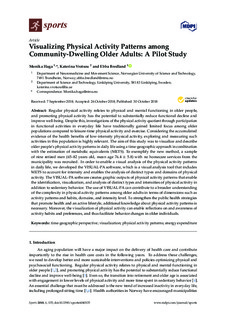| dc.contributor.author | Haga, Monika | |
| dc.contributor.author | Vrotsou, Katerina | |
| dc.contributor.author | Bredland, Ebba | |
| dc.date.accessioned | 2019-01-30T08:15:18Z | |
| dc.date.available | 2019-01-30T08:15:18Z | |
| dc.date.created | 2018-10-30T11:19:06Z | |
| dc.date.issued | 2018 | |
| dc.identifier.issn | 2075-4663 | |
| dc.identifier.uri | http://hdl.handle.net/11250/2582973 | |
| dc.description.abstract | Regular physical activity relates to physical and mental functioning in older people, and promoting physical activity has the potential to substantially reduce functional decline and improve well-being. Despite this, investigations of the physical activity quotient through participation in functional activities in everyday life have traditionally gained limited focus among older populations compared to leisure-time physical activity and exercise. Considering the accumulated evidence of the health benefits of low-intensity physical activity, exploring and measuring such activities in this population is highly relevant. The aim of this study was to visualize and describe older people’s physical activity patterns in daily life using a time-geographic approach in combination with the estimation of metabolic equivalents (METS). To exemplify the new method, a sample of nine retired men (65–82 years old, mean age 76.4 ± 5.8) with no homecare services from the municipality was recruited. In order to enable a visual analysis of the physical activity patterns in daily life, we developed the VISUAL-PA software, which is a visual analysis tool that includes METS to account for intensity and enables the analysis of distinct types and domains of physical activity. The VISUAL-PA software creates graphic outputs of physical activity patterns that enable the identification, visualization, and analysis of distinct types and intensities of physical activity in addition to sedentary behavior. The use of VISUAL-PA can contribute to a broader understanding of the complexity in physical activity patterns among older adults in terms of dimensions such as activity patterns and habits, domains, and intensity level. To strengthen the public health strategies that promote health and an active lifestyle, additional knowledge about physical activity patterns is necessary. Moreover, the visualization of physical activity can enable reflections on and awareness of activity habits and preferences, and thus facilitate behavior changes in older individuals. | nb_NO |
| dc.language.iso | eng | nb_NO |
| dc.publisher | MDPI | nb_NO |
| dc.rights | Navngivelse 4.0 Internasjonal | * |
| dc.rights.uri | http://creativecommons.org/licenses/by/4.0/deed.no | * |
| dc.title | Visualizing Physical Activity Patterns among Community-Dwelling Older Adults: A Pilot Study | nb_NO |
| dc.title.alternative | Visualizing Physical Activity Patterns among Community-Dwelling Older Adults: A Pilot Study | nb_NO |
| dc.type | Journal article | nb_NO |
| dc.type | Peer reviewed | nb_NO |
| dc.description.version | publishedVersion | nb_NO |
| dc.source.volume | 6 | nb_NO |
| dc.source.journal | Sports | nb_NO |
| dc.source.issue | 4 | nb_NO |
| dc.identifier.doi | 10.3390/sports6040135 | |
| dc.identifier.cristin | 1624848 | |
| dc.description.localcode | © 2018 by the authors. Licensee MDPI, Basel, Switzerland. This article is an open access article distributed under the terms and conditions of the Creative Commons Attribution (CC BY) license (http://creativecommons.org/licenses/by/4.0/). | nb_NO |
| cristin.unitcode | 194,65,30,0 | |
| cristin.unitname | Institutt for nevromedisin og bevegelsesvitenskap | |
| cristin.ispublished | true | |
| cristin.fulltext | original | |
| cristin.qualitycode | 1 | |

